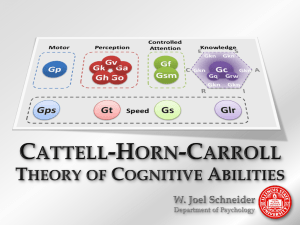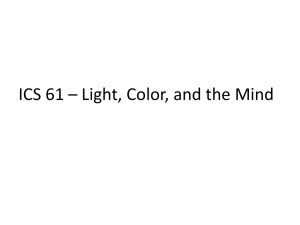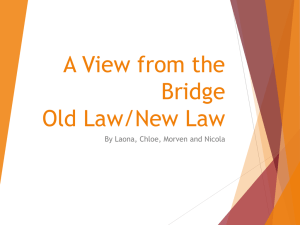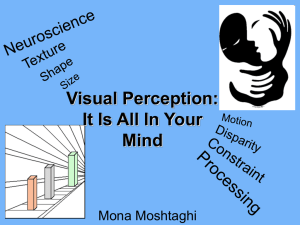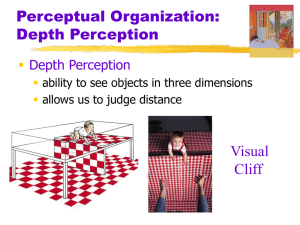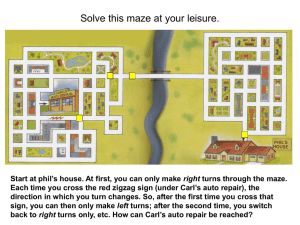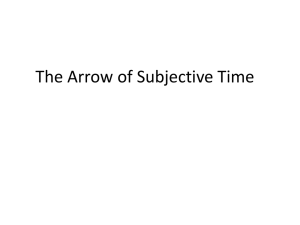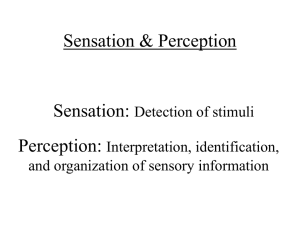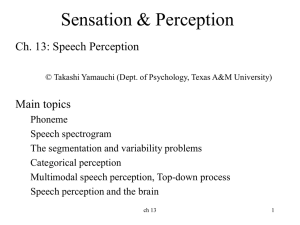Chapter 1
advertisement
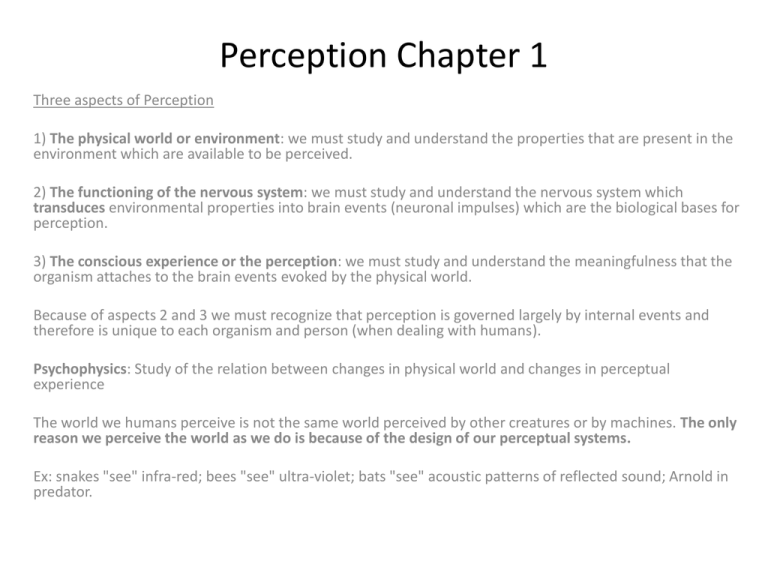
Perception Chapter 1 Three aspects of Perception 1) The physical world or environment: we must study and understand the properties that are present in the environment which are available to be perceived. 2) The functioning of the nervous system: we must study and understand the nervous system which transduces environmental properties into brain events (neuronal impulses) which are the biological bases for perception. 3) The conscious experience or the perception: we must study and understand the meaningfulness that the organism attaches to the brain events evoked by the physical world. Because of aspects 2 and 3 we must recognize that perception is governed largely by internal events and therefore is unique to each organism and person (when dealing with humans). Psychophysics: Study of the relation between changes in physical world and changes in perceptual experience The world we humans perceive is not the same world perceived by other creatures or by machines. The only reason we perceive the world as we do is because of the design of our perceptual systems. Ex: snakes "see" infra-red; bees "see" ultra-violet; bats "see" acoustic patterns of reflected sound; Arnold in predator. It’s all in your head! • We expect “perception” to correspond to “reality,” but that need not be so. The brain and nervous system are designed to be functional, not truthful. • Unperceivable reality and not real perception • Bonnet’s syndrome (visual hallucinations due to damaged visual system), phantom limbs, dreams, etc. • Changes in perception over time – pain in childbirth. Philosophical issues: Can perception be reduced entirely to brain function? • “No” Dualism: Mind and brain are separate substances; perception involves brain function and non-material mental processes (Eccles). Conforms with subjective experience, but violates laws of physics • “Yes” Materialism: Perception arises from brain function. Hard position (Churchlands): Subjective experience is “in” brain even if we can’t find it. Softer position (Sperry): No all subjective experience is reducible to brain function. Emergence: Mind is emergence property of brain; depends on brain, but has own causal power. Overview of Human sensory systems: Near senses: 1) Touch -- mechanoreceptors in skin sensitive to pressure, texture, temperature. 2) Taste -- Chemical receptors on the tongue sensitive to dissolving substances in mouth 3) Smell (olfactory sense) -- olfactory receptor cells in ceiling of nasal cavity sensitive to the chemical properties of vaporous molecules. 1 & 2 require direct contact with to-be-perceived object; 3 requires close contact. Far distance senses: 1) Hearing -- receptor cells in cochlea of the inner ear sensitive to air pressure changes. 2) Vision -- photoreceptors in the retina of eye sensitive to a narrow range of electromagnetic energy •Note how the to-be-perceived object may be quite a distance away form perceiver and still detected. •Note: importance of "active" nature of perception. Philosophical approaches to perception Plato: Fallibility of perception (chained in a cave) John Locke: Primary vs. Secondary qualities Primary: inherent to stimulus (bulk, number, motion shape Secondary: subjective (color, sound, taste, smell) Humean skepticism: we can never be sure of reality because we cannot distinguish between what sensations arise from the object vs. what arises from the mind. -this may be a bit too strong as constructionists would argue that the elaborations of the mind are do follow logical rules and therefore is predictable. Naïve Realism: the world really is as it appears. Reasons to reject: individual variability in perception, ambiguous signals. Subjective Idealism or solipsism: Only perception is real. Berkeley’s Idealism George Berkeley God in the Quad There was a young man who said "God Must find it exceedingly odd To think that the tree Should continue to be When there's no one about in the quad." Reply: "Dear Sir: Your astonishment's odd; I am always about in the quad. And that's why the tree Will continue to be Since observed by, Yours faithfully, God." (poem actually written by: Monsignor Ronald Knox) Levels of analysis in studying perception Psychological: Behavioral measures of detection (verbal response, button pressing, etc.) Phenomenological or Naturalistic: recording subject perceptual experiences in natural setting (colors of sunset). Least formal, only good for human adults (generally); are subjective reports trustworthy? Anton’s syndrome: Blindness with denial. Experimental approaches: Controlling and manipulating stimulus presentation in order to isolate those properties that affect perception. More formal. Concerns: Ecological validity; cross-modal interactions. Levels of analysis in studying perception Biological: Connection perceptual experience with biological (brain, nervous system) activity. Lesion studies: brain damage and loss of function Transcranial magnetic stimulation: delivery of magnetic energy to specific brain regions to disrupt function. Event related potentials: use of electrodes to monitor electrical activity of brain Positron Emission Tomography: blood flow followed by radioactive tracer (limited spatial resolution) Function magnetic resonance imaging: blood flow followed by changes in magnetic potential of oxygenated blood (good spatial, not so good temporal resolution) Magnetoencephalography (MEG): Measures external magnetic fields (expensive, but great temporal resolution) Brain imaging technologies Magnetoencephalography (MEG) Measures external magnetic fields Transcranial magnetic stimulation Produces ‘virtual’ lesions Brain imaging technologies • Positron Emission Tomography (PET) • Makes use of radioactive tracer to measure cerebral blood flow. Brain imaging technologies • Functional Magnetic Resonance Imaging (fMRI) • Uses electromagnets to measure oxygen levels in brain. Theoretical approaches • Interactive levels of explanation (highest to lowest) 1. The perceptual problem to be solved (e.g. recognizing a face or hitting a base-ball) 2. The “programming rules” used to address the problem (figure/ground – face from background; up/down vs. left/right – eyes from mouth, etc.) 3. Neural machinery used to implement rules (fusiform face area in temporal lobe)



